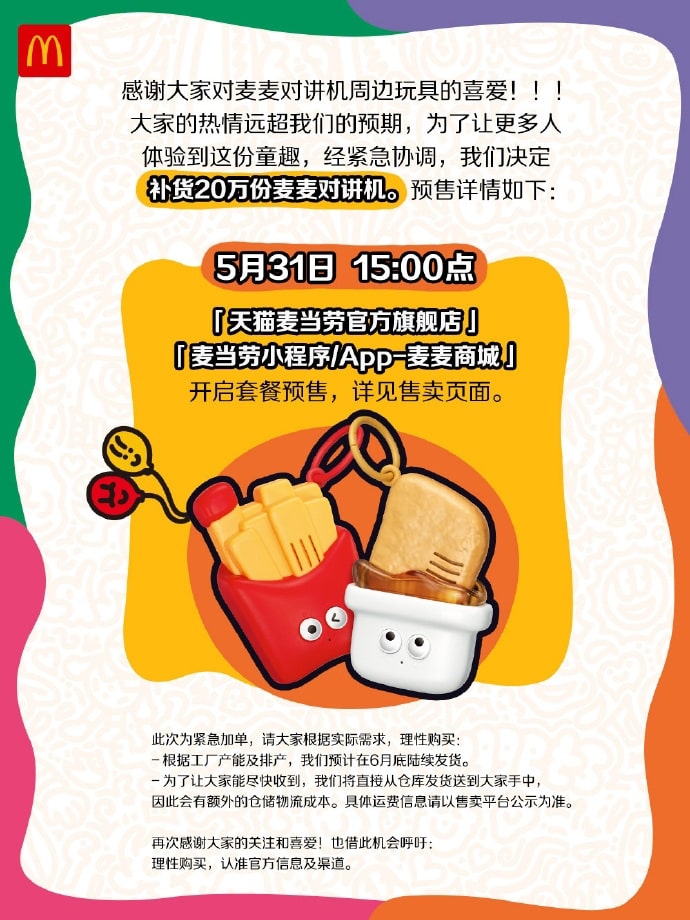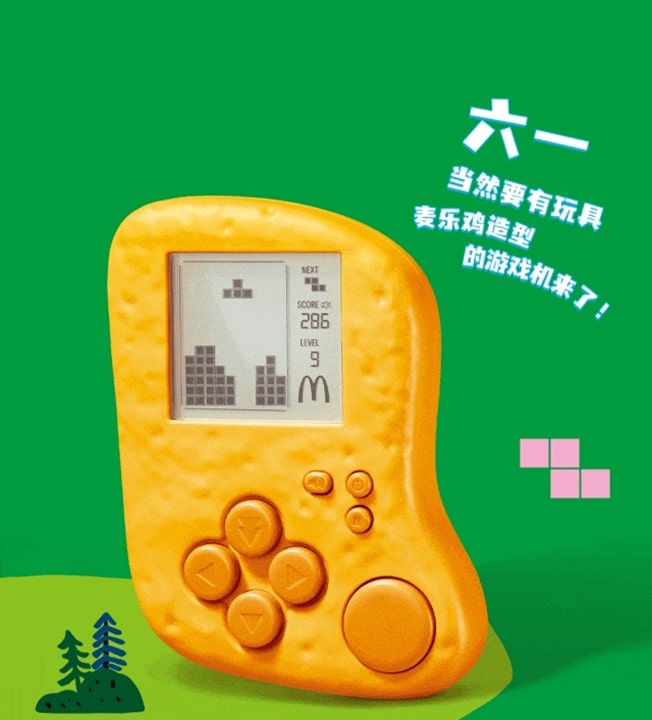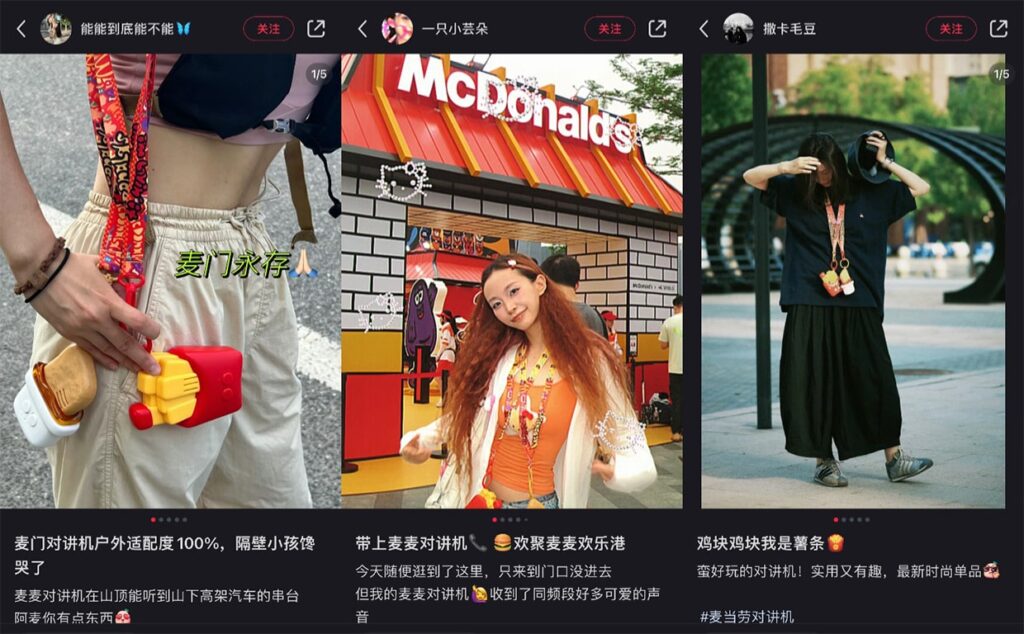In the run-up to this year’s Children’s Day in China on June 1, the globally renowned fast food chain McDonald’s initiated a series of activities focusing on its classic McNuggets. McDonald’s engaged international artist Sam Cox, also known as Mr Doodle, to create unique graffiti-style paintings featuring McNuggets and exclusive images of the brand’s iconic characters, including Grimace, Hamburglar, and Birdie the Early Bird. The brand also launched a special offer of 20 McNuggets for RMB 20 (USD 2.7). However, it was arguably the release of a limited-edition “McTalkie” toy that captured the hearts of the masses.
Designed to resemble McNuggets and fries, the McTalkie was available for purchase along with a graffiti sticker at McDonald’s outlets in China for an additional RMB 38 (USD 5.2). When it went on sale on May 22, ahead of Children’s Day, the McDonald’s app crashed shortly after due to overwhelming demand. In an interview with 36Kr, a Nanjing store manager said that the McTalkie toys sold out within an hour after opening, with listings quickly appearing on Goofish (Xianyu), an e-commerce platform for secondhand goods, at prices ranging from RMB 39–70 (USD 5.3–9.6). The enthusiasm also spurred a batch of scalpers, with the McTalkie toys being resold for up to RMB 300 (USD 41.3), nearly a tenfold increase from the original price of RMB 38.
The popularity of the new toy extended beyond scalping activity, with enthusiasts disassembling the toy and discovering its chip might be the Broadcom BK4802, boosting the Nasdaq-listed company’s stock with three consecutive limit ups. To accommodate the demand, McDonald’s urgently replenished the stock, announcing on May 29 via Weibo that it had restocked 200,000 more sets of the McTalkie toy.

A history of frenzy
This isn’t the first time McDonald’s has caused a frenzy with its toy releases. Last Children’s Day, it released a Tetris game console shaped like a McNugget to celebrate the 40th anniversary of McNuggets, which also sold out nearly immediately.

It’s worth noting that the idea of giving toys as part of a meal traces back to the birth of the Happy Meal, which has changed restaurant marketing, kickstarting a trend of toy giveaways that now extend beyond the fast food scene.
This trend appeals not only to children and families but also to adult consumers. According to 36Kr, the Nanjing store manager mentioned that most McTalkie buyers were adults. The manager also claimed that McDonald’s drove around RMB 26.6 million in sales within a few days after the campaign kicked off, excluding meal costs.
The appeal of micro-moments
In recent years, major holidays like Lunar New Year and Christmas have lost some of their allure, as expectations tend to skyrocket during these big occasions, making even the most creative marketing strategies seem mundane. In contrast, micro-moments are easier to manage and can help brands stand out with a touch of creativity. These smaller celebrations tap into the everyday excitement people seek.
Children’s Day is a perfect example—it gives adults a rare chance to embrace their inner child, and brands can capitalize on this opportunity. Accordingly, the holiday appeals not just to children but to adults eager to relive their childhood, and McDonald’s McTalkie toy is a prime example of how the brand leverages this nostalgic demand to great effect.
Another reason why McDonald’s toys capture consumers’ hearts is their playability. Whether it’s last year’s Tetris game console or this year’s McTalkie, these offerings are not limited to simple figurines but emphasize engagement with and between consumers. A common way McDonald’s achieves this is by ensuring high playability of their toys.
According to JX Liu, a Medium blogger, disassembling the McTalkie reveals a decently constructed toy comprising a motherboard, antenna, and speaker—implying that it is a functional walkie-talkie, albeit one that’s at best average in quality. Liu noted that, in terms of performance, the communication range of the McTalkie is quite significant, reaching up to 300 meters in an open, unobstructed environment during testing, although it can only operate on one standardized channel, meaning everyone using it is essentially speaking in a public chat room.
Interaction between consumers and the toys can also spur word-of-mouth and online discussion, further expanding reach.
For example, a Xiaohongshu blogger shared online that the McTalkie’s transmission range outperformed a RMB 299 (USD 41.2) Disney walkie-talkie, further boosting the toy and brand’s popularity. Couple these factors with the limited-edition strategy adopted by McDonald’s for the McTalkie, and it becomes increasingly clear why the release has stimulated consumer desire to great effect. Scarcity marketing creates a sense of rarity by limiting supply, elevating the product’s appeal and perceived value. Consumers may therefore feel a sense of urgency to make a purchase quickly, especially if the product offers a distinct appeal. This was evident in the app’s crash following the McTalkie’s release on May 22.

Nostalgia and brand power
However, not all brands can achieve the same effect simply by copying the tactics utilized by McDonald’s. The fast food chain’s blend of product ingenuity, scarcity marketing, and the capability to leverage a distinct appeal—in this case, nostalgia—works extremely well in part due to its strong brand power.
Specifically, McDonald’s is often perceived as more than just a fast food restaurant, but also a pop culture machine. Its strategies, while commercially attuned, have historically extended beyond to explain or influence contemporary culture. Sociologist George Ritzer is most known for using McDonald’s business as a model to analyze the general process of rationalization in modern society, introducing the concept of McDonaldization, which has since been widely referenced in academia across various parts of the world.
In China, the first Happy Meal toys were launched in 1990, the same year McDonald’s entered the Chinese market. Today, Happy Meals are available in roughly 2,200 restaurants nationwide, with new toys released approximately every four weeks. In 2019, McDonald’s sold about 35 million Happy Meals in China, with demand fueled by the launch of toys themed after various IPs such as Disney, Hello Kitty, Pokemon, and more. Many of these remain highly sought after in the secondhand market.
If anything, McDonald’s was once a surprise contender for the title of the world’s largest toy distributor. In 2001, the brand was reportedly distributing 1.5 billion toys annually worldwide, more than Hasbro and Mattel combined. It’s hard to find another brand in the world with as much appeal as McDonald’s, and logically so because it represents one of those rare instances where a business has managed to build and sustain massive brand power.
The popularity of McDonald’s is perhaps best exemplified with its logo—in an unfamiliar place, you might not know the local language or how to get around, but you won’t go hungry in a place with McDonald’s because it is recognizable solely by the big yellow “M.”
No matter the place, McDonald’s offers a taste of home—a beacon of consistency, embodying a comforting familiarity that transcends borders and cultures. The McTalkie craze is simply another testament to the brand’s universal appeal and its ability to bring joy to people of all ages.

